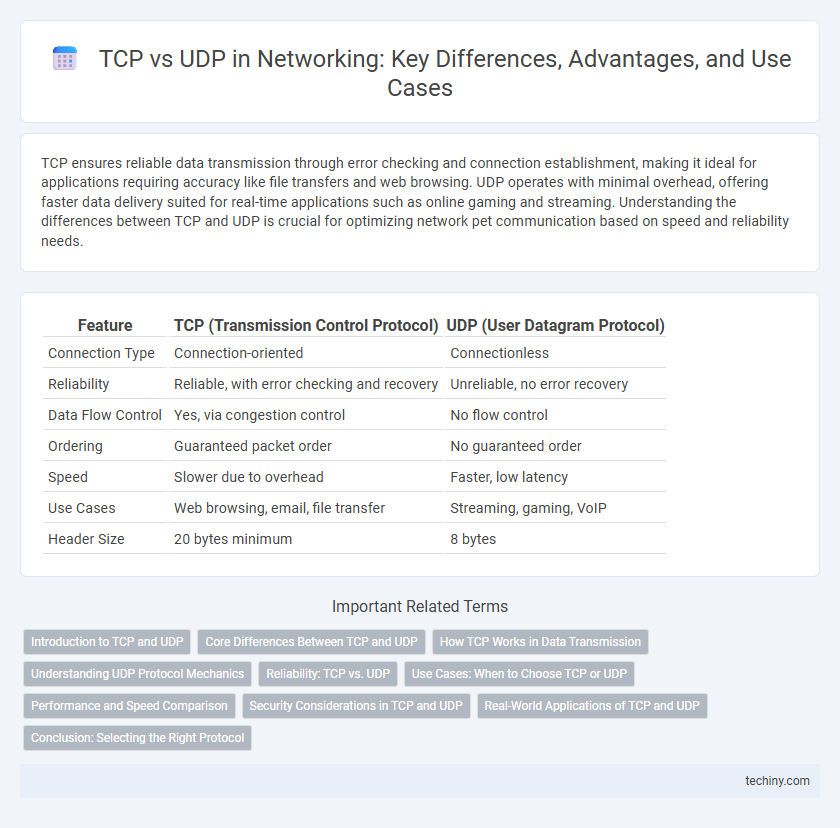TCP ensures reliable data transmission through error checking and connection establishment, making it ideal for applications requiring accuracy like file transfers and web browsing. UDP operates with minimal overhead, offering faster data delivery suited for real-time applications such as online gaming and streaming. Understanding the differences between TCP and UDP is crucial for optimizing network pet communication based on speed and reliability needs.
Table of Comparison
| Feature | TCP (Transmission Control Protocol) | UDP (User Datagram Protocol) |
|---|---|---|
| Connection Type | Connection-oriented | Connectionless |
| Reliability | Reliable, with error checking and recovery | Unreliable, no error recovery |
| Data Flow Control | Yes, via congestion control | No flow control |
| Ordering | Guaranteed packet order | No guaranteed order |
| Speed | Slower due to overhead | Faster, low latency |
| Use Cases | Web browsing, email, file transfer | Streaming, gaming, VoIP |
| Header Size | 20 bytes minimum | 8 bytes |
Introduction to TCP and UDP
Transmission Control Protocol (TCP) and User Datagram Protocol (UDP) are fundamental transport layer protocols in networking. TCP provides reliable, connection-oriented communication with error checking and congestion control, making it suitable for applications requiring data integrity. UDP offers a faster, connectionless service without guaranteed delivery, ideal for real-time applications like streaming and gaming.
Core Differences Between TCP and UDP
TCP (Transmission Control Protocol) ensures reliable data transmission through error checking, flow control, and connection-oriented communication, making it ideal for applications requiring accuracy, such as web browsing and email. UDP (User Datagram Protocol) offers faster data transfer by using connectionless communication without error recovery, suited for real-time applications like video streaming and online gaming. The core difference lies in TCP's guaranteed delivery versus UDP's speed and simplicity, impacting performance and use case selection in networking.
How TCP Works in Data Transmission
TCP establishes a reliable connection through a three-way handshake process, ensuring both the sender and receiver are synchronized before data transfer begins. Data is segmented into packets, each acknowledged by the receiver, which guarantees ordered delivery and retransmission of lost packets. Flow control and congestion control mechanisms manage network traffic efficiently, preventing packet loss and maintaining optimal transmission speeds.
Understanding UDP Protocol Mechanics
UDP (User Datagram Protocol) operates as a connectionless protocol, transmitting data packets called datagrams without establishing a prior connection, which reduces latency and overhead. Unlike TCP, UDP does not guarantee delivery, order, or error checking, making it ideal for applications like live streaming and online gaming where speed is critical. Its lightweight nature allows for faster data transmission, relying on the application layer to handle error correction and flow control.
Reliability: TCP vs. UDP
TCP ensures reliable data transmission by establishing a connection through a three-way handshake and using error-checking mechanisms like acknowledgments and retransmissions to guarantee packet delivery. UDP, in contrast, operates as a connectionless protocol without built-in error correction, leading to faster data transfer but potential packet loss and unordered delivery. The choice between TCP and UDP hinges on the application's need for reliability versus speed, with TCP favored for accuracy and UDP for low-latency communication.
Use Cases: When to Choose TCP or UDP
TCP is ideal for applications requiring reliable data transfer and error correction, such as web browsing, email, and file transfers, where data integrity and order matter. UDP suits real-time applications like video streaming, online gaming, and VoIP, where low latency and speed outweigh occasional packet loss. Choosing between TCP and UDP depends on the need for reliability versus speed in network communication.
Performance and Speed Comparison
TCP ensures reliable data transmission through error checking and retransmission, which can introduce latency and reduce overall speed. UDP offers faster performance by sending packets without acknowledgment, making it ideal for real-time applications like gaming and streaming where speed is critical. Network environments requiring low latency benefit from UDP, while those needing data integrity prefer TCP despite its slower speed.
Security Considerations in TCP and UDP
TCP offers enhanced security features such as built-in error checking, connection-oriented communication, and congestion control, which reduce the risk of data corruption and unauthorized data interception. UDP, being connectionless and lacking inherent error correction, is more vulnerable to spoofing, packet injection, and denial-of-service attacks. Network security protocols often favor TCP for applications requiring reliable data transmission and secure communication channels.
Real-World Applications of TCP and UDP
TCP powers reliable applications such as web browsing, email, and file transfers by ensuring data integrity and ordered delivery. UDP supports real-time services like online gaming, live video streaming, and VoIP by minimizing latency and tolerating occasional data loss. Network architects select TCP or UDP based on application requirements for speed, reliability, and traffic type.
Conclusion: Selecting the Right Protocol
Choosing between TCP and UDP depends on the specific networking requirements, where TCP offers reliable, connection-oriented transmission ideal for data integrity and order, while UDP provides faster, connectionless communication suited for real-time applications like streaming and gaming. Network designers must assess factors such as latency tolerance, packet loss acceptance, and application sensitivity to determine the optimal protocol. Balancing reliability and speed ensures efficient data transmission aligned with the use case demands.
TCP vs UDP Infographic

 techiny.com
techiny.com